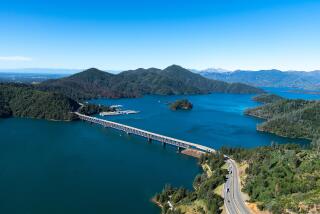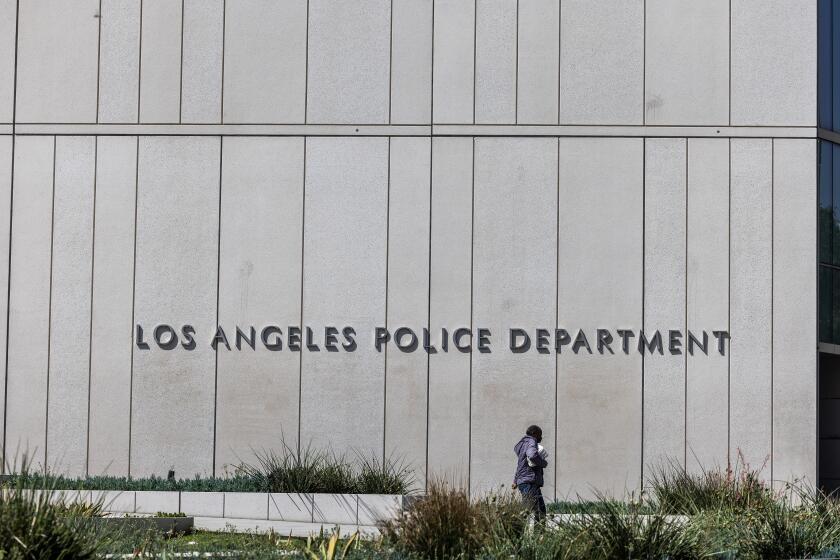Underground Mess : CCDC May Ask State Aid in Removing Fuel Plume
San Diego redevelopment officials, leery of a legal mine field that awaits them as they attempt to dry up a lake of gasoline and diesel fuel floating under several blocks of valuable downtown land, want more assurances of help from a state water quality agency before moving ahead with their $5-million cleanup plan.
That recommendation made Wednesday by Pam Hamilton, the top executive of the Centre City Development Corp., the city’s downtown redevelopment organization, means that while the CCDC wants to move ahead as quickly as possible to clean up the so-called underground plume, it doesn’t want to move so fast as to open itself to legal liability or make it difficult to recoup costs from private property owners responsible for the pollution.
Hamilton’s suggestion, contained in a report, will be discussed Friday morning by the CCDC board of directors, which will hold a public hearing on the comprehensive, multimillion-dollar cleanup proposal made by a toxic-waste consultant.
Timetable Could Expand
The proposal, released late last month, says it will take as long as four years and $5.3 million to clean up the underground plume that now encompasses all or parts of nine blocks in the Marina area. That timetable could expand under Hamilton’s recommendation, however, if the CCDC is unable to obtain adequate assurances from the state Regional Water Quality Control Board.
The recovery plan, made by International Technology Corp., is the first detailed look at how long it will take and how much it will cost to get rid of the plume, which threatens to undermine revitalization in the Marina area, one of downtown redevelopment’s most active and high-profile areas.
Already, the CCDC has spent several hundred thousand dollars constructing and operating a series of test wells and a pump station, as well as buying a small parcel of land for the pump station.
Almost from the time the underground lake was discovered more than two years ago, CCDC officials have said they would work with various state and county pollution control agencies to identify and find the people responsible for the plume, a daunting task in some respects because parts of the 460,000-gallon lake may be decades old, left by businesses such as gasoline stations that, in many cases, are no longer there.
Several other sources of the contamination, however, have tentatively been identified, although no formal action against anyone has yet occurred.
The CCDC’s thinking has been that, in cases where those contributing to the pollution could not be immediately identified, it would pay for the cleanup and recover its costs later. But Hamilton’s recommendation shows that the CCDC is not ready to jump in that quickly without some specific legal and economic safeguards.
Seeking State’s Attention
Her recommendation that the CCDC seek more assurances of help from the water quality board also seems to indicate that the CCDC is increasing efforts to gain the state agency’s attention.
Nearly a year ago, the CCDC board approved an agreement enabling the water quality board to help the CCDC recover its cleanup costs from property owners responsible for the contamination. Wednesday’s recommendation, however, covers some of the same ground.
For example, among the five conditions contained in Hamilton’s recommendation--a sort of list of prerequisites she says should be accomplished before the cleanup plan is implemented--is that the water quality board “diligently pursue the identification of the sources of the hydrocarbon plume.”
In addition, Hamilton’s recommendation includes requests that the state agency use its authority to “require cleanup of the plume by the responsible parties at their expense.”
Also, Hamilton wants to see whether the state agency can use its power to come up with an “accelerated procedure to clean up the plume” in a way that ensures the CCDC is able to recoup its costs later from property owners guilty of contributing to it.
By following the recommendation, Hamilton said in her report, the CCDC would be legally protected from liability stemming from the cleanup.
Hamilton was unavailable for comment, but David Allsbrook, the CCDC staff member most closely involved with the plume problem, said, “We want to mesh our process with the regional board.”
“Our attitude has been to get this done as quickly as possible but from the best possible position for cost recovery,” he said.
Allsbrook said he didn’t know and could not estimate how long it will take to get the assurances from the water quality board. He referred that question to David T. Barker, a senior engineer with the board. Barker was unavailable for comment.
More to Read
Start your day right
Sign up for Essential California for news, features and recommendations from the L.A. Times and beyond in your inbox six days a week.
You may occasionally receive promotional content from the Los Angeles Times.






